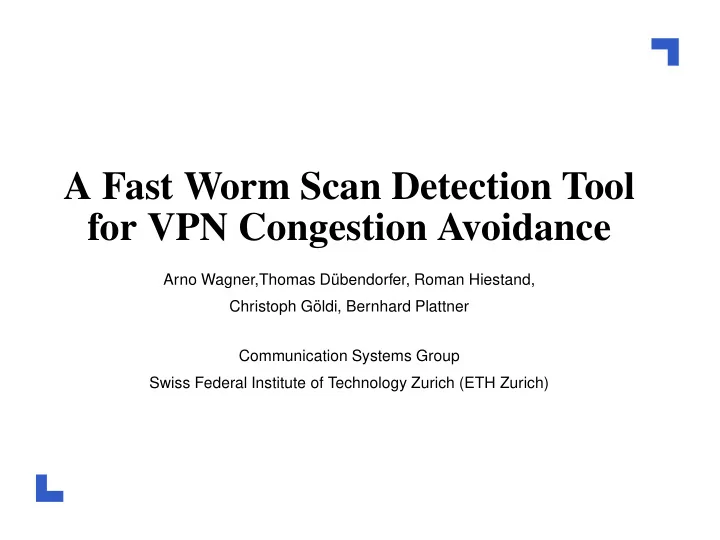

A Fast Worm Scan Detection Tool for VPN Congestion Avoidance Arno Wagner,Thomas D¨ ubendorfer, Roman Hiestand, Christoph G¨ oldi, Bernhard Plattner Communication Systems Group Swiss Federal Institute of Technology Zurich (ETH Zurich)
Outline 1. Setting 2. Problem Statement 3. Design Goals 4. Approach 5. Implementation 6. Tests, Validation 7. Remarks Arno Wagner, ETH Zurich, DIMVA 2006 – p.1
Setting Collaboration between OpenSystems AG, Zurich and Communication Systems Group (CSG) at ETH Zurich OpenSystems: Provides, e.g., managed VPN links on OpenSystems hardware (Linux based industrial PCs) Administration remotely from Zurich NOC Customers in 70 countries > 100 VPN links operational Arno Wagner, ETH Zurich, DIMVA 2006 – p.2
Problem Statement Internet links: SAT-phones, . . . , high-speed Internet Congestion can cause significant problems Remote diagnosis can be difficult Customers may need their links repaired very fast IT competence at customers sites varies strongly Diagnosis has to be done remotely by OpenSystems ⇒ Typically requires several hours of manual work One main congestion source: Worm infected hosts Arno Wagner, ETH Zurich, DIMVA 2006 – p.3
Design Goals The scan traffic detector needs to: Run on the VPN endpoints (detection is for attached network, not VPN tunnel) Communicate only when problems are detected Have low resource needs Detect scan and DoS traffic fast Identify infected hosts Have a low false positives rate Arno Wagner, ETH Zurich, DIMVA 2006 – p.4
Approach Main approach: Failed connection counting on a per-host basis Relatively simple for TCP Still works for UDP and ICMP Idea is well documented in the literature Arno Wagner, ETH Zurich, DIMVA 2006 – p.5
TCP Scan Detection Each active host has a state Measurements are done incrementally Identified infected hosts are ignored to reduce load Arno Wagner, ETH Zurich, DIMVA 2006 – p.6
TCP Host Flowchart I first failed TCP connection TCP_BENIGN no > 100 failed conn. in < 2 minutes yes TCP_SCAN failed conn. no to >100 hosts in < 5 minutes yes Arno Wagner, ETH Zurich, DIMVA 2006 – p.7
TCP Host Flowchart II back to TCP_BENIGN failed conn. > 1200 failed no no TCP_SAMEPORT_SCAN conn. to < 5 hosts in to >100 hosts in < 4 min < 5 minutes yes yes DoS TCP_HOST_SCAN TCP_DOS failed conn. to failed conn. no no > 100 hosts on the same TCP_HOST_NOTSAMEPORT_SCAN to > 300 hosts in port in < 5 min. < 5 min. yes yes WORM WORM TCP_HOST_SAMEPORT_SCAN TCP_HOST_PORT_SCAN Arno Wagner, ETH Zurich, DIMVA 2006 – p.8
UDP Scan Detection Similar to TCP , but failed ”connection” can be UDP packet, no answering packet UDP packet, answering ICMP ”destination unreachable” Further differences: Thresholds are different More traffic needed to trigger detection Arno Wagner, ETH Zurich, DIMVA 2006 – p.9
ICMP Scan Detection Similar to TCP , but No port checks Failed ”connections” possibilities (not distinguished): ICMP ”destination unreachable” ICMP requests without answer Arno Wagner, ETH Zurich, DIMVA 2006 – p.10
Detection Latency Tests are done serially to conserve memory + No traffic needs to be stored - Worst case detection time is higher But: More scan traffic gives faster detection Worst case detection times are still reasonable (TCP: 17 min, UDP: 18 min) Arno Wagner, ETH Zurich, DIMVA 2006 – p.11
Implementation VPN node: P4 2.4GHz, 1GB RAM, 2 * FE, 2 * GbE, customised 2.4 kernel Detector: Uses Bro intrusion detection system Traffic capturing via libpcap Event propagation via system log Alerting via OpenSystems log monitor Arno Wagner, ETH Zurich, DIMVA 2006 – p.12
Performance I 4 infected hosts, simulated TCP worm traffic (MACE) 1 cpu usage (%) 0 0 1 2 3 4 5 6 7 8 9 10 time (min) Memory load stays below 8MB Arno Wagner, ETH Zurich, DIMVA 2006 – p.13
Performance II 252 infected hosts, simulated TCP worm traffic (MACE) 80 70 60 cpu usage (%) 50 40 30 20 10 0 0 1 2 3 4 5 6 7 8 9 10 time (min) Memory load stays below 20MB Arno Wagner, ETH Zurich, DIMVA 2006 – p.14
Validation The detector was tested with Blaster worm (real infection) SQL Slammer worm (real infection) Simulated worm traffic by MACE 22 hours of productive traffic from 15 VPN links ⇒ No false positives Several different P2P filesharing applications ⇒ Alerts from eMule when firewalled and searching Arno Wagner, ETH Zurich, DIMVA 2006 – p.15
Remarks I Detector is used in OpenSystems production environment Source code available upon request: Detector scripts (Bro): GPL MACE extensions: non-commercial use Very successful project: Students: Very good master’s thesis OpenSystems: Practical solution of a real problem ETH: Paper at DIMVA’06 Arno Wagner, ETH Zurich, DIMVA 2006 – p.16
Remarks II: Collaboration Industrial collaboration with OpenSystems on student theses works well. No money flows Topics must be of interest to all sides Everybody invests real effort and shapes results Mutual understanding of different goals Produced software GPL where possible Important: Avoid ”problem students” Arno Wagner, ETH Zurich, DIMVA 2006 – p.17
Thank You! Arno Wagner, ETH Zurich, DIMVA 2006 – p.18
Recommend
More recommend